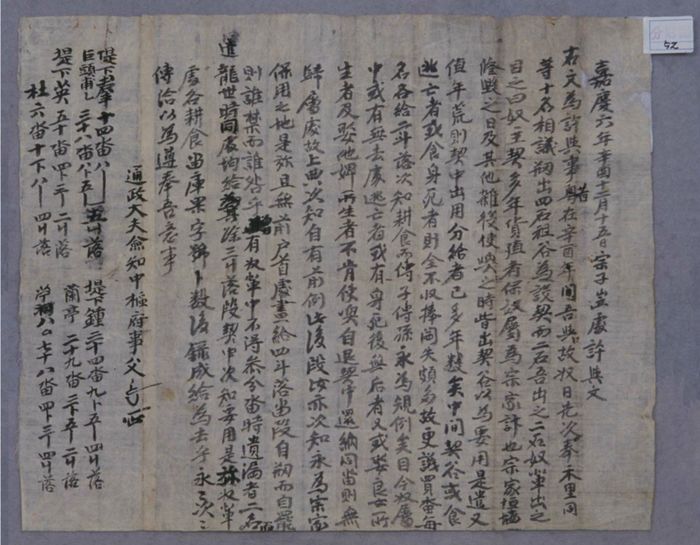"(Translation) 1801年 李希誠 衿給文記"의 두 판 사이의 차이
Henrylee2018 (토론 | 기여) (→Student 9 : (Mengheng Lee)) |
(→Student 3 : Hu JIng) |
||
| 91번째 줄: | 91번째 줄: | ||
*Discussion Questions: | *Discussion Questions: | ||
| − | 1. What can we learn from this document in terms of the relation between the yangban and nobi in Joseon dynasty, particularly when thinking | + | 1. What can we learn from this document in terms of the relation between the yangban and nobi in Joseon dynasty, particularly when thinking of that the slavery system was under transition at the point? |
==='''Student 4 : (Write your name)'''=== | ==='''Student 4 : (Write your name)'''=== | ||
2018년 7월 12일 (목) 11:27 판
| Primary Source | ||
|---|---|---|
 |
Title | |
| English | ||
| Chinese | 1801年 李希誠 衿給文記 | |
| Korean(RR) | 1801년 이희성 깃급문기 (Yi Hui-seong gis-geub-mun-gi) | |
| Text Details | ||
| Genre | Social Life and Economic Strategies | |
| Type | Record | |
| Author(s) | 李希誠 | |
| Year | 1801 | |
| Source | ||
| Key Concepts | Master-slave Compact | |
| Translation Info | ||
| Translator(s) | Participants of 2018 Summer Hanmun Workshop (Advanced Translation Group) | |
| Editor(s) | ||
| Year | 2018 | |
목차
- 1 Introduction
- 2 Original Script
- 3 Discussion Questions
- 4 Further Readings
- 5 References
- 6 Translation
- 6.1 (sample) : Jaeyoon Song
- 6.2 Student 1 : (Write your name)
- 6.3 Student 2 : (Write your name)
- 6.4 Student 3 : Hu JIng
- 6.5 Student 4 : (Write your name)
- 6.6 Student 5 : Inho Choi
- 6.7 Student 6 : (Write your name)
- 6.8 Student 7 : King Kwong Wong
- 6.9 Student 8 : Younès M'Ghari
- 6.10 Student 9 : (Mengheng Lee)
- 6.11 Student 10 : (Ji-Hyun Lee)
- 6.12 Student 11 : Lee Goeun
- 6.13 Student 12 : (Write your name)
- 6.14 Student 13 : (Write your name)
- 6.15 Student 14 : (Write your name)
Introduction
Original Script
| Classical Chinese | English |
|---|---|
|
嘉慶六年辛酉十二月十五日宗子岦處許與文 右文爲許與事 昔在辛酉年間 吾與故奴日先次奉禾里同等十名相議 刱出四石租谷爲設契 而二石吾出之 二石奴輩出之 因之曰奴主契 多年貨殖者 保奴屬爲宗家計也 宗家坦檣修毁之日 及其他雜役使喚之時 皆出契谷 以爲要用是遣 又値年荒 則契中出用分給者 已多年數矣 中間契穀[1] 或食或逃亡者 或食身死者 則全不收捧 閪失頗多 故更議買畓 每名各給二斗落[2]次知耕食 而傳子傳孫 永爲規例矣 目今奴屬中 或有無去處逃亡者 或有身死後無後者 又或娶良女所生者 及娶他婢所生者 不肯使喚 自退契中 還納同畓 則無歸屬處 故上典次知自有前例 此後段 汝亦次知 永爲宗家保用之地是旀 且無前戶首處劃給四斗落段 自刱而自罷 則誰禁而誰咎乎 曾有奴輩中 不得參分畓時遺漏者二名 而龍世時同處均給爲㫆 其餘三斗落段 契中次知要用是旀 奴輩處各耕食畓庫果 字號卜數後錄成給爲去乎 永永次次 傳給以爲遵奉吾意事 通政大夫僉知中樞府事 父 (着名署押)
(後錄 -생략)
|
(translation) |
Discussion Questions
Further Readings
References
- ↑ ‘契谷’은 契員이 出資한 곡식으로서 ‘契穀’이 맞으나 음가가 같으므로 ‘谷’자로도 흔히 사용하였다.
- ↑ 畓二斗落=600坪(1斗落=300坪, 1坪 =3.3058㎡)=1,983.48㎡=0.49ac(1ac=4,047㎡)
Translation
(sample) : Jaeyoon Song
- Discussion Questions:
Student 1 : (Write your name)
old document, slavery-slave compact, economic and social status of slaves , property distribution
- Discussion Questions:
Is all these documents written by the owner of the slaves themselves or by someone at a specific position? How are they going to ensure the legality of these compact?
Student 2 : (Write your name)
key words: slaves, master, compact, land, property, descendants social history, social mobility, tenant farmers,
- Discussion Questions:
What were the significances of the abolishment of 從賤法 and establishment of 從良法?
Student 3 : Hu JIng
- key words: yangban-nobi relation, economic life in Joseon, compact, social mobility in Joseon
- Discussion Questions:
1. What can we learn from this document in terms of the relation between the yangban and nobi in Joseon dynasty, particularly when thinking of that the slavery system was under transition at the point?
Student 4 : (Write your name)
Inheritance Practices, Transformation of Korean slavery system
- Discussion Questions:
Student 5 : Inho Choi
Master-Slave compact, Inheritance, Choson Slavery, Choson social history, Social Mobility
- Discussion Questions:
Is 契 a financial arrangement, a legal document, or both. Is 契 a exclusively private arrangement, or does government somehow guarantee its effect and helps its enforcement? Is there any shift in the meaning of 奴 in the early 19th century that allows them to make a compact with their master?
Student 6 : (Write your name)
- Discussion Questions:
Student 7 : King Kwong Wong
- Keywords:
economic and social relationship between master and slaves, changing social condition, hereditary status of slaves
- Discussion Questions:
Student 8 : Younès M'Ghari
- Key Concepts:
master-slave contract, legacy transmission, usage of slaves
- Discussion Questions:
Student 9 : (Mengheng Lee)
- keyword:
slavery, the social status system, and social mobility in Chosŏn Korea, slave-master compact, and documents of distribution of property.
- Discussion Questions:
1. To what extent could we say that this document shows the increased social mobility in Chosŏn Korea?
2. What is the nature of slave-master compact that we can conceptualize from this document?
3. What's the historical significance of this document?
Student 10 : (Ji-Hyun Lee)
奴主契 slave-master compact,
奴婢 slavery
宗家 head-family
分財記 inheritance document
land and property distribution
Chosŏn contract
- Discussion Questions:
Student 11 : Lee Goeun
- Discussion Questions: Since when such compact between master and slaves began to appear in Joseon? Was this common in the society? Was there a regional difference or tendency?
- Key Concepts: Changing social strata in the turn to 19c Joseon
Student 12 : (Write your name)
- Discussion Questions:
Student 13 : (Write your name)
- Discussion Questions:
Student 14 : (Write your name)
- Discussion Questions: